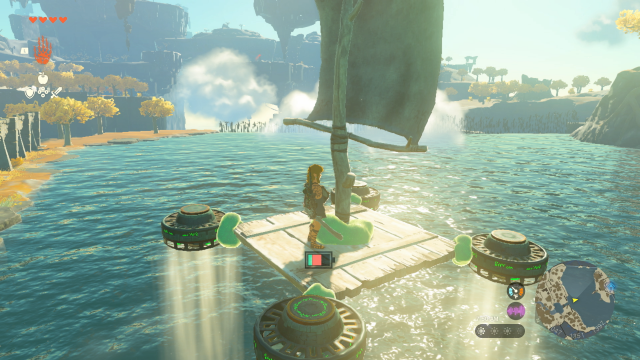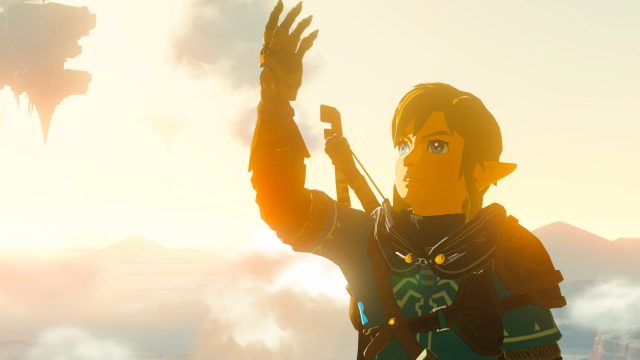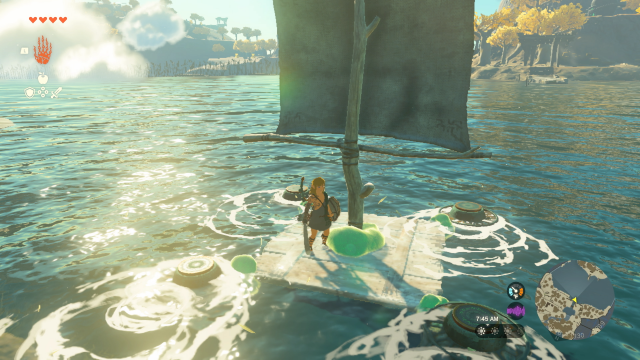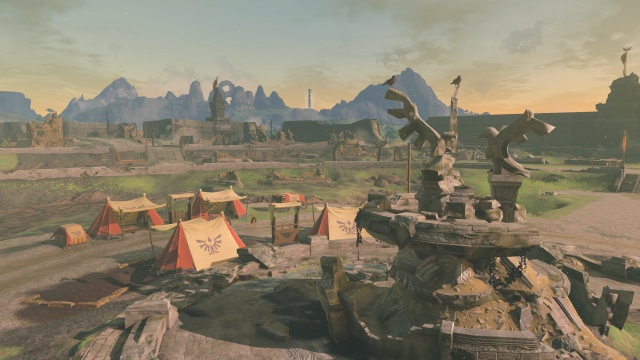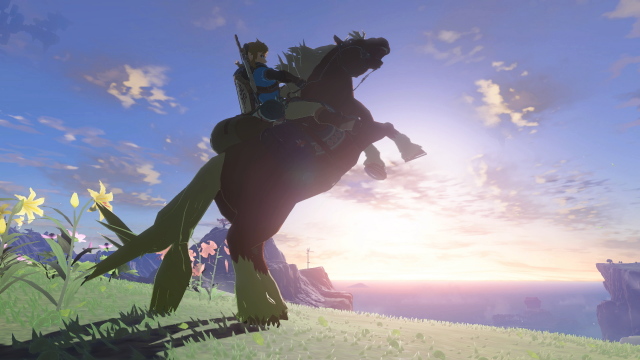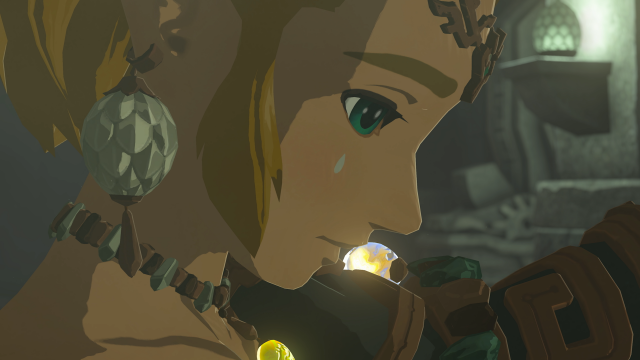New runes are impressive and ambitious; Huge new area is a fantastic complement to the rest of the game; Main story significantly improved from previous game
Opening hours are slow; Link feels like a ghost in a world that doesn’t recognize him; Baffling UI/UX choices
You don’t need me to tell you that The Legend of Zelda: Tears of the Kingdom’s predecessor was well-received. The Legend of Zelda: Breath of the Wild sits near the top of Metacritic’s all time best list, it outsold the next two best-selling Zelda games combined, and coverage of its speedrunning techniques, glitches, and comedy sandbox antics continue to pay the bills for both legacy games media and upstart content creators. But despite Breath of the Wild’s plaudits, it was also one of those landmark sequels that alienated a portion of its traditional audience, like Resident Evil 4 or the newer Assassin’s Creed games. I wasn’t among the doubters – Breath was my favorite Zelda game ever at the time of its release – but as I understand it the chief complaints were:
- Disappointing story
- Weapon durability
- Lack of structured overworld objectives
- Shrines and divine beasts as a replacement for traditional dungeons
As for how well Tears addresses these complaints, we’ll get there, but in short the answers are, respectively: somewhat, not exactly, definitely, and somewhat. It’s a mixed bag but if your favorite Zelda was an older 3D title like Ocarina of Time or Twilight Princess, you’ll likely at least prefer Tears to its predecessor.
If, on the other hand, you were one of the many who loved Breath like me, you may have been hopeful but unsure whether Tears could recapture what seemed like lightning in a bottle, and the answer is that it doesn’t exactly, but is nevertheless a tour de force and remains a very easy game to recommend.
The strangest thing about Tears is its story, hands down. If you look at the cinematic cutscenes in isolation, they’re a huge step up from the story on offer in Breath, and they include some of the best narrative moments in the series. The relationship between Link and Zelda, the endless divine struggle between good and evil as mediated by the series’ three primary characters, and in particular Zelda’s arc are all really strong in Tears.
If, instead, you look at everything else surrounding that central cinematic story, things fray and fall apart. Structurally, it’s an uncreative retread of Breath for the bulk of its runtime – complete the tutorial area, then visit the four regions in turn to engage in formulaic quests and cutscenes. For most players, the Rito questline will be the first of the four, and it makes a great first impression, but it’s hard not to be disengaged when copy-paste cutscenes play out at the end of each subsequent arc. Worse still are all the strange little ways Tears does or doesn’t connect to Breath. Hudson, the mushroom-haired founder of Tarrey Town, remembers you. But Bolson, his spry boss who built your house, acts like he’s never seen you before. So does basically every single resident of Hateno, where your house was built in Breath. So does Hestu, shalaka. It’s one thing for a game to not take its story seriously. It’s another for a game to put effort into a story and then be so completely haphazard about it. It’s frankly maddening, and makes Link feel like a ghost.
In Breath, Link was responsible for the mass graveyard of wrecked Guardians just west of Hateno. Then, 100 years later, he shows up, pumps thousands of rupees into the local Hateno economy, builds his forever home in Hateno, serves as an emissary connecting every other major settlement to Tarrey Town, recaptures all four Divine Beasts, drives the Hearty Durian to extinction, frees the princess, destroys the giant evil 10,000 year old cursed howling miasma circling Hyrule Castle, disables the countless spider-legged Terminators roaming the countryside, kills a 200 foot tall demon boar, and saves everyone. It is patently ridiculous that anybody in Hyrule would fail to recognize Link. In Adventure of Link, Link’s Awakening, Majora’s Mask, and Phantom Hourglass, the returning hero is cast into strange lands. It makes sense that those Links are strangers. But Nintendo chose to set the direct sequel to Breath in the same location as Breath.
You might say that Nintendo can’t assume any given Breath of the Wild player met Bolson, or Hestu, or anyone else. But Nintendo didn’t have to assume that – Tears already reads your Breath save file to check for the presence of a saved horse the first time you visit a stable, and for at least one other thing I won’t spoil. Tears already knows whether you built a house in Hateno or helped Hestu fill his maracas or freed the Master Sword. It just doesn’t care, and in turn that makes it hard to care about the world beyond its main story. Nobody is expecting Nintendo to rise to the level of longtime Western RPG developers like Bioware, Obsidian, or CD Projekt Red when it comes to story reactivity, but we should expect the world to make sense.
On top of all of the above, the game’s open structure makes no assumptions as to the order the player completes the four regional quests vs some other major quests, including this game’s equivalent of Breath’s photo memory quest. In Tears, if you complete the (very enticing) memory quest early, the remainder of the regional quests will be absolutely maddening, as the behavior of Link in those cutscenes will no longer make sense given things Link has learned.
As in a classic Mega Man game, the chief way Tears of the Kingdom keeps the experience fresh despite a very similar structure is in giving the player a new set of abilities. Out are Magnesis, Remote Bomb, Stasis, Cryonis, Revali’s Gale, Daruk’s Protection, Mipha’s Grace, and Urbosa’s Fury. In their place are an extremely powerful but somewhat unwieldy set of new abilities: Ultrahand, Fuse, Recall, Ascend, and the replacements for Breath’s Champion powers. In short, Ultrahand lets the player attach objects to each other in arbitrary ways, for problem solving and traversal; Fuse lets the player strengthen or add strange properties to weapons, shields, and arrows; Recall lets the player rewind the position of objects; and Ascend lets the player move vertically without climbing.
The most immediately clear difference between the new and old runes is that the new runes do not have much direct combat application outside of Fuse. Remote Bombs were a reliable source of damage and a way to separate packs of enemies, Stasis+ let you unhorse riders and line up headshots, and Cryonis could be used to shield against ranged attacks or gain a height advantage for your own bow attacks. Anyone who tried their hand at Breath’s Trial of the Sword or Eventide Island knows how vital it was to master the flow and application of these runes in combat. That dimension of Breath’s combat is simply absent from Tears, and its absence results in a somewhat lackluster opening few hours.
Fuse, by its nature, is very open-ended but also very resource-dependent, so early on when the player is strapped for consumable items, combat is much duller than in the corresponding stretch of Breath. However, as the player gets farther into the game, unlocks more inventory slots via Hestu, and acquires more Zonai Devices and other consumables, Fuse becomes very versatile and powerful, almost ludicrously so. Homing arrows and detonating shields barely scratch the surface. Fuse on its own wouldn’t be that much of a game changer except that the list of farmable consumable items in Tears has been massively expanded to include light sources, smoke bombs, mind control plants, and more. Even crazier are the Zonai Devices, which at first seem like they’re mostly present for the sake of Ultrahand, but have some very strange and empowering effects when Fused to a shield.
Fuse does relatively little to address durability complaints from the first game, but I won’t say it does nothing. The thing about Fuse is that it makes a weapon’s base attack power less important than its other properties (the moveset and the bonus), and the fused item then adds either its own properties or a big boost of attack power, or both. Because the fused items come out of your inventory, they aren’t limited by the number of weapon slots you’ve unlocked via Hestu. When a weapon breaks, just pick up any random stick or rusty piece of garbage, use Fuse to attach one of the surplus strong items in your inventory, and continue with your day. The chore of dealing with breakable weapons is still there, but the risk of being stranded without decent gear as stuff starts to break is gone, because “decent” is now defined not by what enemies are carrying but by what’s in your pocket.
The other three runes have very little combat application outside of combat prep and positioning, with minor exceptions like using Ultrahand to move an enemy’s dropped weapon, or using Recall to send a tossed boulder or bomb barrel back at the enemy that threw it. Using Recall in this way, however, comes across as a somewhat anemic recreation of Breath of the Wild’s thrilling Guardian laser parries. The real showcase for Recall is in puzzle solving in Shrines and Dungeons (and in serving as an Undo button for some Ultrahand-related snafus).
Before I get to Ultrahand, though, let me praise Ascend. At first blush it’s the most conceptually modest of the Tears runes, but it’s essentially the best version of the Hookshot this series has ever produced. Instead of looking around for the Hookshot target or another self-tutorializing puzzle switch as is common in older 3D Zelda games, Ascend relies on your ability to remember to use it. I can’t tell you how many times I found myself unsure how to reach higher ground or make progress, only to slap my head and remember Ascend. It changes Link’s relationship to vertical space in a game with so much of it, and while it’s not my favorite rune across these two games, I do think it’s the most elegant and most perfect.
That leaves Ultrahand, which is both impressive and messy. Conjoining objects has two main purposes in this game. First, you can solve puzzles, usually in Shrines or Dungeons, sometimes in concert with Recall to jury rig a moving platform. Because of the physics sandbox (and Fuse, and Zonai Devices) there are once again numerous solutions available to most of these puzzles, but it does seem like Ultrahand is the linchpin of most intended solutions, and the selection of conjoinable objects in each Shrine suggests a particular approach. The other main use of Ultrahand is in vehicle construction, using a mix of mundane construction materials and Zonai Devices. Put wheels on a board to make a cart, or put a flame emitter on a balloon to reach wild heights, or put a lot of things on a lot of other things. The sky’s the limit. Especially with the amount of explorable terrain so greatly expanded, there’s a lot of opportunity to reach what seem like obviously inaccessible areas, or construct ludicrous war machines to take into combat.
Reviewers almost all love Ultrahand, but the general reception from fans has been more mixed if still positive, and it’s not hard to see why both camps feel the way they do. It’s phenomenal for creating stories to talk about or clips to share, and I’m sure we’ll be seeing goofy Ultrahand-powered clips on social media for years. It also allows the player to build and iterate on an absolutely wild range of ways to interact with the world’s sandbox. On the other hand, even more than breakable weapons, Ultrahand runs counter to the core fantasy of Zelda. Link has always been not just a warrior but a problem solver, sure, like the heroes of Greek myth. He’s clever and inventive, but he’s still also a guy with a sword, interacting directly with the world.
Ultrahand vehicles put a layer of interaction abstraction between the Hero of the Wild and the wilds. I don’t want to interact with a fantasy kingdom as a ramshackle battlebot. I want to interact with it as a spunky little dude. Worse, though, is the expanse between Ultrahand ideation and execution. That has always been one of the worst part of Zelda games, to be fair. You look at a puzzle, you figure out the puzzle, and then you have to spend a couple of minutes moving everything into place, sometimes with a trial and error component. That gap between idea and execution can be dull and frustrating, and after Breath did so much to alleviate it (outside of climbing), Ultrahand brings it back worse than ever. Instead of slowly moving blocks around, you’re slowly moving everything around. All of the rotation, the finicky physics, the trial and error – it can be a real drag on the pacing if you’re not in the mood for psychic IKEA assembly.
If you loved Breath of the Wild’s slapstick elements, you’ll still appreciate Ultrahand despite its frustrations. Perhaps because of Breath’s enduring success on social media, slapstick was the one element of Breath that Nintendo most clearly decided to optimize for in Tears. Overturned vehicles, accidentally unmanned vehicles, unceremoniously catapulted enemies, and fire everywhere. It’s a circus, and easily the funniest single player experience Nintendo has ever produced.
As for what replaces the Champion abilities, I won’t spoil their specifics. They have more universal combat and puzzle application than the Champion abilities did; Daruk and Mipha were basically redundant with other survivability boosts like armor upgrades, Hearty foods, defense buffs, and fairies. These replacements are also gained earlier in the regional quests than the Champion abilities were in Breath, meaning that the four regions all have a stronger mechanical identity. These abilities are, from a certain point of view, a return of classic Zelda items, and simultaneously a suitable replacement for the loss of Remote Bombs. They are so, so close to being an absolute successful synthesis of old and new Zelda. Unfortunately, their usage is mapped to the overloaded A button and tied to game objects that move according to their own AI, meaning that it’s both extremely easy to use them accidentally when trying to interact with an object, and extremely hard to use them when you want to. It’s not the only baffling UI decision in this game, but it is the most damaging. It would be incredibly easy for Nintendo to fix with a patch, but I’m not holding my breath.
It’s a testament to the game designers at Nintendo that re-exploring Hyrule holds up as well as it does. Some of the changes are predictable if welcome, like changing the locations of the towers, shrines, great fairies, and notable enemies. More unexpected but still fairly mundane are the new wells and caves, with the addition of new fauna like Horriblins and Like Likes well-suited to subterranean crawl spaces. Even the addition of two extra map layers a la Yakuza 4 feels like a natural step, if a very good one. The upper map layer, the sky islands, was heavily featured in promotional material and even the box art. It’s a relatively modest addition, serving mostly as a series of small puzzley areas that double as very convenient fast travel points. The lower map layer, The Depths, was featured only briefly and cryptically in promotional materials, so I won’t say too much about its contents despite its early introduction. What most impressed me about the entire game was The Depths and its relation to the surface of Hyrule. It’s the element that honestly made the game feel big and new even after several Breath of the Wild playthroughs. More than that, though, it was the element that helped compensate for unwelcome changes to the game’s exploration and quest structure.
Of the complaints Breath of the Wild critics had, the one that Nintendo most took to heart was around quest structure and exploration incentives. The number of collectibles and metric-tracking quests (do X of Y to get a new Z) has ballooned, as has the quest ledger generally. The number of side quests has almost doubled, from 76 in Breath to 139 in Tears. You certainly won’t find all of those without setting out with that goal, and you certainly don’t have to complete all of those side quests, but they are most definitely present. There are so many NPCs with so much dialogue giving you breadcrumbs for so many explicit objectives. If like me you loved Breath of the Wild for how expertly it was designed to feel unstructured, it may well disappoint to have the game keep shoving the latest edition of Lonely Planet Hyrule in your face. On the othe hand, if you missed that structure in Breath, it’s probably going to feel like the single axis on which the game is most improved. Me, I missed the wild.
That’s where The Depths come in. Very light on quests and very dark otherwise, The Depths invite you to struggle to explore a massive area, its nature, and its relationship to the world above. When the surface and its points of interest had me overwhelmed, The Depths were a refuge I could retreat to. It eventually got a little old, but that’s okay – it had already made the preceding dozens of hours so much more enjoyable than they otherwise would have been. It’s not just more overworld or more puzzles like the other two map layers; The Depths are something different.
Still, like almost every other open world game, Tears eventually bores. Fuse, which blossoms the further you get into the game, eventually leads the player to be even more overpowered than they were in Breath of the Wild, which is saying something. However, because of the player’s ability to stockpile and spend a large variety of powerful fusables/consumables, the endgame stays satisfying longer than it did in Breath. Eventually you’re getting Silver Lynel Horns faster than you can spend them, especially if combining them with the special properties of weapons that double their power, but even still you end up with such a wild set of verbs that it stays compelling, at least for a while.
As for what you’re stabbing with those Silver Lynel Horns, the increased enemy variety in Tears is a big boon, and most helps in the midgame as your Fuse-enabling resource list expands but you haven’t yet fully overpowered every challenge. Disappointingly, after six years Nintendo still hasn’t managed to improve upon or even match the Lynels as an apex predator. There are some flashy contenders, but despite their intimidation factor Gleeoks are neutered disappointingly quickly by slow motion arrow spam, and the one other particularly nasty surprise that I won’t spoil is still easy prey for Bomb Flowers once the shock wears off. Additionally, while most of the bestiary from Breath has been brought forward, that game’s second-best enemy design (the Guardian Stalker) is missing from Tears, and with it any meaningful utility for the parry. In the early game it’s very easy to die, sure, but the high-end bestiary is still lacking. This game’s wild toolkit would benefit from some honest optional superbosses or other ways to narrow the power gap between Link and his increasingly hapless opponents.
On that note, while Breath’s Eventide Island has lost its scavenger/guerrilla warfare gimmick in Tears, and the similar Trial of the Sword is nowhere to be found, the replacement of “Trial of Strength” combat shrines with mini-Eventide combat scenarios has resulted in what are reliably the best Shrines across both titles. Beyond those perfect little bites of Tears at its scrappy best, most puzzle Shrines aren’t particularly impressive and are about on par with those in Breath, and while Breath’s terrible gyro marble puzzles are gone, the slow tutorial shrines added in Tears may be even worse. Why, 20 hours into a direct sequel, am I being asked whether I know what a headshot is?
Finally, the dungeons aren’t that different mechanically, but the context makes all the difference. Every dungeon has a long linear approach where you acclimate to its core mechanics and build anticipation and atmosphere. These are all pretty successful even if none are truly knockouts. The subsequent dungeons are basically just glorified Divine Beasts in terms of structure and challenge, but the atmosphere, music, and bespoke bosses really do make a difference. Not all of the bosses are winners in terms of combat design, but even the underwhelming bosses in Tears are charming, unlike the repetitive Blights.
All in all, while Tears of the Kingdom isn’t perfect, it’s a classic maximalist sequel and it succeeds at that, whatever baggage or quibbles various players might bring to it. It was never going to supplant Ocarina of Time among that game’s diehards. Neither will it supplant Breath of the Wild thanks to how thoroughly the former wilderness has been tamed and signposted. After six years, something more revelatory or revolutionary would have been quite welcome, but in the end the worst I can say about Tears of the Kingdom is that it’s a very good game that earns its place in the Zelda pantheon.




 ShareThis
ShareThis